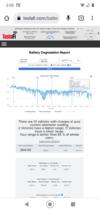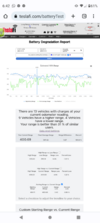There is an independent service that can monitor your battery health.
Recurrent | Buy, Drive & Sell Your Electric Car, Positively
I have been pretty meticulous about taking care of my battery. Recurrent Auto has some good information and they try and quantify how much extra value you have in your car by managing degradation. In over a year, my S has seen 1% or less in degradation. In about the same time, my 3 has effectively seen no degradation or is better than some 3's that are brand new. My S has seen some supercharger use and my 3 none.
Early on I read what
@AAKEE posted about battery degradation and came up with a simple plan to maximize my health. Recurrent auto has pretty much validated that approach works for me.
As I mentioned upstream, I keep my cars at 50% or less. I only charge up more when absolutely needed and only just before I go. I try and avoid supercharger use and typically only charge then from 15-65%. All in all it is pretty simple to do. The worst things you can do seem to be charge your car to a high level in hot weather and keep it there.
I basically never have any need to charge over 60% on my S because of its range. A big plus for it is even at a low charge level, it is still wickedly fast. The performance on the new S drops off very little until I am around 20% charge or under. The 3 is a little more obvious but even at a 25% I am still under 4 seconds 0-60.






